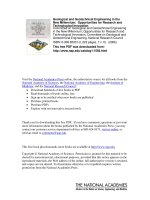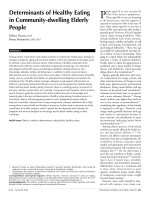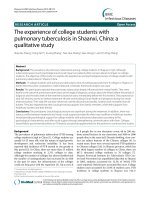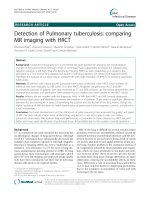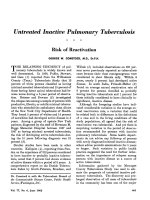Tài liệu Manifestations of Pulmonary Tuberculosis in the Elderly: A Prospective Observational Study from North India pptx
Bạn đang xem bản rút gọn của tài liệu. Xem và tải ngay bản đầy đủ của tài liệu tại đây (37.81 KB, 6 trang )
[Received: May 7, 2007; accepted after revision: November 5, 2007]
Correspondence and reprint requests: Dr Dheeraj Gupta, Additional Professor, Department of Pulmonary Medicine, Post
Graduate Institute of Medical Education and Research (PGIMER), Sector 12, Chandigarh-160 012, India; Phone: 91-172-
2756823; Fax: 91-172-2748215, 91-172-2745959; E-mail:
Original Article
Manifestations of Pulmonary Tuberculosis in the Elderly:
A Prospective Observational Study from North India
Dheeraj Gupta
1
, Navneet Singh
1
, Ravinder Kumar
2
and Surinder K. Jindal
1
Departments of Pulmonary Medicine
1
and Internal Medicine
2
, Post Graduate Institute of Medical Education
and Research (PGIMER), Chandigarh, India
ABSTRACT
Background. There is scarcity of published literature on manifestations of pulmonary tuberculosis (PTB) among elderly
patients in India. The aim of the present study was to compare the clinical, radiological and laboratory manifestations of
PTB among young and elderly patients.
Methods. This prospective study involved 100 human immunodeficiency virus (HIV) negative patients with PTB. The
demographic, clinical, radiological and laboratory manifestations were compared between young (n=50; under 60 years of
age) and elderly (n=50; aged 60 years and above) with PTB.
Results. Elderly patients, in comparison to younger patients, tended to be heavier smokers and had more co-morbidities
(40% vs 8%; p < 0.05). They presented more frequently with constitutional symptoms (except fever) and less frequently with
respiratory symptoms. The mean duration of symptoms and rate of sputum smear-positivity for acid-fast bacilli was similar
in both groups. Both the groups were similar with respect to physical examination and chest radiograph findings. Median
values of erythrocyte sedimentation rate and total leukocyte count were significantly higher and lower respectively in the
elderly patients.
Conclusions. The presentation of PTB in elderly patients differs from that of younger patients by the predominance of
constitutional rather than respiratory symptoms. A high index of suspicion is required to make a timely diagnosis of
tuberculosis in the elderly.
[Indian J Chest Dis Allied Sci 2008; 50: 263-267]
Key words: Constitutional, Elderly, Pulmonary, Respiratory, Symptoms, Tuberculosis.
INTRODUCTION
Tuberculosis (TB) remains a major challenge for health-
care workers throughout the world despite major
progress in the development of new strategies for its
diagnosis and treatment. In elderly patients, the clinical
and radiological presentations are often nonspecific,
leading to a delay in diagnosis and in initiating
appropriate treatment, which often results in a
significant proportion of cases being discovered at
autopsy only.
1
There is scarcity of published literature
on manifestations of TB especially pulmonary
tuberculosis (PTB) among elderly patients from India.
The aim of the present study was to compare the
clinical, radiological and laboratory manifestations of
PTB among elderly patients (above the age of 60 years)
with those in young patients (below the age of 60 years).
MATERIAL AND METHODS
This prospective study involved a total of 100 human
immunodeficiency virus (HIV) negative patients with
PTB. Elderly (n=50; Group I; aged 60 years and above)
and young (n=50; Group II; under 60 years) patient were
selected from those being treated as out-patients (at the
Chest Clinic) or in-patients (admitted to any of the
wards) at Post Graduate Institute of Medical Education
and Research (PGIMER), Chandigarh. Patients with
PTB in whom sputum smear revealed acid-fast bacilli
(AFB) and/or culture grew Mycobacterium tuberculosis
were included. Patients who were sputum smear-
negative for AFB and in whom the diagnosis of PTB was
established on the basis of clinical and radiological
features consistent with TB and a good clinical response
to antituberculosis treatment (ATT) were also enrolled
in the study.
2
The study also
included patients with PTB
who had concomitant evidence of extrapulmonary TB
(EPTB). The diagnosis of EPTB was based on clinical
and radiological features suggestive of TB concerning
the involved site with supportive evidence in the form
of demonstration of AFB and/or granulomas/caseous
necrosis from specimens obtained from the affected site.
264
Pulmonary Tuberculosis in the Elderly D. Gupta et al
Patients who were HIV seropositive, those on
immunosuppressive drugs or with underlying
haematological malignancies, were excluded from the
study.
All patients underwent a detailed clinical evaluation.
Details noted included history of fever, constitutional or
respiratory symptoms, duration of symptoms, duration
and quantity of tobacco smoking, past medical and
treatment history. Tobacco smoking was further
categorised after calculation of smoking index (the
product of the number of cigarettes/bidis smoked per
day and the number of years for which they had been
smoked). All patients underwent haematological
(complete hemogram) and biochemical (liver and renal
function tests, fasting and post-prandial blood sugar
testing) laboratory tests and a chest radiograph.
Serological testing for HIV was conducted at the
Voluntary Counselling and Testing Centre (VCTC)
located within PGIMER, Chandigarh after taking
informed consent from the patients. All patients had
three consecutive sputum smears examined for the
presence of AFB using Ziehl-Neelsen technique. This
was done as per recommendations of the Revised
National Tuberculosis Control Programme (RNTCP),
Government of India at the Designated Microscopy
Centre (DMC) located within PGIMER, Chandigarh.
Sputum induction was attempted in patients who were
not producing sputum spontaneously. The study was
cleared by the ethics committee of the Institute.
Informed consent was taken for each subject.
Statistical Analysis
Quantitative and qualitative data are expressed as
median [inter-quartile (IQ) range] and percentages
respectively. Quantitative variables were compared
using Mann-Whitney U test while qualitative variables
were compared using Pearson Chi-square test. A ‘p’
value of less than 0.05 was considered significant.
RESULTS
The demographic characteristics of patients in the two
groups are shown in table 1. Although male
predominance was seen in both the groups, there was
no difference in the gender distribution. Patients in
Group I tended to be heavier smokers compared to those
in Group II; the percentage of patients having a smoking
index of more than 300 being 30% and 2% respectively
(p<0.05). A significant percentage of elderly patients
(40%) had chronic diseases and were on long-term
medication for the same (32%); the most common co-
morbid illness being diabetes mellitus (16%).
Isolated PTB was the most common presentation
(86% and 82% in Groups I and II respectively). Among
patients with PTB who also had EPTB, the most
common site of extra pulmonary involvement was
Table 1. Demographic characteristics of elderly (Group I) and
young (Group II) patients with pulmonary tuberculosis
Characteristic Group I Group II
(
≥≥
≥≥
≥ 60 years) (< 60 years)
(n = 50) (n = 50)
No. (%) No. (%)
Male : Female 32 : 18 32 : 18
Mean age + SD (years)* 63.1 ± 3.9 30.2 ± 9.4
Smokers : Non-smokers 21 : 29 18 : 32
Smoking index
< 100 2 (4) 7 (14)
101-300 4 (8) 9 (18)
> 300* 15 (30) 2 (4)
H/o ATT in past 18 (36) 23 (46)
Presence of chronic disease(s) 20 (40) 4 (8)
Diabetes mellitus 8 (16) 1 (2)
Hypertension 2 (4) 0 (0)
COPD 1 (2) 0 (0)
CAD 1 (2) 0 (0)
CRF I (2) 0 (0)
Other diseases 7 (14) 3 (6)
Use of regular medication(s) for 16 (32) 2 (4)
chronic disease(s)
*p < 0.05; ATT = Antituberculosis treatment
COPD = Chronic obstructive pulmonary disease
CAD = Coronary artery disease, CRF = Chronic renal failure.
lymph nodes (n=3, in Group I; n=5 in Group II). None of
the observed differences (Table 2) between the two
groups with respect to extrapulmonary involvement
were statistically significant.
Comparison of the clinical features among patients in
both groups is presented in table 2. Elderly patients, in
comparison to younger patients, presented more
frequently with constitutional symptoms and less
frequently with respiratory symptoms. The duration of
symptoms prior to diagnosis was similar (median 2; IQ
range 1-5 weeks) in elderly and young patients. Rate of
sputum smear-positivity for AFB was also similar in
Groups I and II [29/41 (70.7%) vs 35/48 (72.9%)
respectively]. Seven patients in Group I and five in Group
II who did not report with sputum production initially
could provide an adequate sample for testing following
sputum induction. There was no significant difference
in the two groups with respect to findings on the chest
radiograph (Table 3).
Elderly patients (Group I), in comparison to younger
patients (Group II), had higher median (IQ range) values
of erythrocyte sedimentation rate (ESR) [49 (35-64) vs 32
(16-55) mm at the end of the first hour] and lower mean
values of total leucocyte count (TLC) [7000 (6000-8800)
vs 8100 (6200-11600) mm/µL]. Other haematological
and biochemical results were similar in both the groups.
DISCUSSION
Tuberculosis is becoming increasingly common in the
elderly and burden of the disease in them is likely to
continue to increase substantially.
3,4
Moreover, with
increasing age, a state of relative deficiency develops as
2008; Vol. 50 The Indian Journal of Chest Diseases & Allied Sciences 265
a result of a reduction in the number and function of the
T-helper lymphocytes and an increase in the presence of
T-suppressor cells. This decline in natural immunity
enhances the possibility of endogenous reactivation of
infection by Mycobacterium tuberculosis bacilli and the
development of active TB.
5
Pulmonary tuberculosis is
the most common form of TB even in the elderly
although EPTB is more frequently seen than in the
young.
6,7
Presentation of PTB in the elderly often differs from
that in younger patients and some authors have even
suggested that PTB in the elderly may even be
considered as a distinct disease entity.
8
These differences
can lead to a delay in the diagnosis of TB in the elderly,
which in turn, can lead to an increase in the morbidity
and mortality in them.
9, 10
A recent meta-analysis
11
of 12 published studies
sought to compare the clinical, radiological and
laboratory features of PTB among older and younger
patients. This meta-analysis
11
did not reveal any
significant difference between the two groups with
respect to male preponderance, evolution time before
diagnosis, prevalence of certain respiratory symptoms
(cough, sputum production), presence of upper lobe
lesions on chest radiographs, detection rate of AFB in
sputum, haemoglobin levels and serum
aminotransferases. However, several other clinical
manifestations differed significantly between the
younger and older patients. Fever and sweating were
observed less frequently among the older patients and
this was attributed to the reduced pyrogenic response
with ageing. Dyspnoea was more prevalent in the
elderly and this could be explained in part by the
decline in pulmonary function that occurs with ageing.
Haemoptysis was less common among the elderly and
correlated with the lower prevalence of cavitary disease.
Lower levels of serum albumin and blood leucocytes
were noticed among older patients. A higher prevalence
of co-morbid conditions like diabetes mellitus,
cardiovascular disorders and chronic obstructive
pulmonary disease was seen in the elderly TB patients.
These differences in the presentation of PTB among the
elderly can thus be explained by well known
physiological changes that are known to occur with
ageing and hence must be kept in mind during the
diagnostic evaluation of elderly patients.
11
Several findings of the current study are in
accordance with the results of this meta-analysis. In the
present study, male preponderance, mean duration of
symptoms prior to diagnosis, rates of sputum smear
AFB positivity and chest radiograph findings were
similar in both the age groups. Lower frequency of
respiratory symptoms and fever, lower mean values of
TLC as well as higher prevalence of chronic co-morbid
illnesses in the elderly patients were also observed in
the current study.
However, certain findings of the current study
differed from those of the meta-analysis
11
and included
Table 3. Radiographic features in elderly (Group I) and young
(Group II) patients with pulmonary tuberculosis
Characteristic Group I Group II
(
≥≥
≥≥
≥ 60 years) (< 60 years)
(n = 50) (n = 50)
No. (%) No. (%)
Normal chest radiograph 3 (6) 6 (12)
Infiltrates 13 (26) 17 (34)
Consolidation 13 (26) 13 (26)
Collapse 0 (0) 3 (6)
Hilar lymph node enlargement 3 (6) 2 (4)
Pleural effusion/thickening 9 (18) 8 (16)
Miliary shadows 3 (6) 1 (2)
Cavitation 16 (32) 19 (38)
Fibrosis 13 (26) 14 (28)
“Destroyed lung”* 5 (10) 8 (16)
Calcified nodules 3 (6) 1 (2)
*Extensive fibrocavitary disease involving both lobes of one
lung that is associated with volume loss and tracheal/
mediastinal shift and with normal/near normal lung fields
on the opposite side.
Table 2. Clinical features in elderly (Group I) and young (Group
II) patients with pulmonary tuberculosis
Characteristic Group I Group II
(
≥≥
≥≥
≥ 60 years) (< 60 years)
(n = 50) (n = 50)
No. (%) No. (%)
Site of Involvement
Isolated pulmonary TB 43 (86) 41 (82)
Pulmonary and extrapulmonary TB 7 (14) 9 (18)
Lymph node TB 3 (6) 5 (10)
Pleural TB 3 (6) 2 (4)
Osteoarticular TB 1 (2) 2 (4)
Respiratory Symptoms
Cough* 37 (74) 48 (96)
Sputum* 34 (68) 43 (86)
Haemoptysis* 7 (14) 16 (32)
Chest pain 19 (38) 25 (50)
Breathlessness 23 (46) 29 (58)
Constitutional Symptoms
Fever 37 (74) 42 (84)
Anorexia* 45 (90) 34 (68)
Weight loss* 40 (80) 30 (60)
Night sweats* 25 (50) 9 (18)
General Physical Examination
Normal 15 (30) 11 (22)
Pallor 18 (36) 16 (32)
Cyanosis 0 (0) 0 (0)
Jaundice 0 (0) 0 (0)
Pedal oedema 3 (6) 1 (2)
Lymphnode enlargement 6 (12) 9 (18)
Thin built 23 (46) 28 (56)
Fever 2 (4) 4 (8)
Respiratory System Examination
Normal 20 (40) 13 (26)
Bronchial breath sounds 10 (20) 12 (24)
Reduced intensity of breath sounds 9 (18) 13 (26)
Crepitations 0 (0) 1 (2)
Any other finding 0 (0) 1 (2)
*p < 0.05, TB = Tuberculosis.
266
a higher frequency of constitutional symptoms (other
than fever) in the elderly patients. It is well known that
the clinical presentation of TB can often be atypical and
subtle in the elderly and that symptoms like
unexplained weight loss, “failure to thrive,” weakness
or a change in cognitive status may be the sole
manifestation of the disease.
12
Recent retrospective
studies from Korea
10
and Hong Kong
13
have found
similar observations regarding an increase in the
presence of constitutional symptoms in elderly patients
with TB. This results in a delay in the presentation of the
elderly to health care facilities, thereby resulting in a
delay in the commencement of ATT. The delay in
presentation among elderly patients with TB has also
been documented previous study by Arora et al
14
from
Himachal Pradesh. In that study,
14
only 36.9% of
patients presented within three months of onset of
symptoms, while 41.2% presented after six months of
onset of symptom. Most of the patients (78.1%) had
advanced disease radiologically at the time of
diagnosis.
14
In the current study, a higher percentage of elderly
patients were heavy smokers (SI > 300). By virtue of
age, it is expected that elderly patients would have
smoked more. However, heavy smoking is associated
with a relative risk of 2 to 4 for developing TB.
5,15
Current smokers, in comparison with never-smokers,
have a higher risk of developing PTB but not EPTB.
15
Furthermore, patients who develop TB tend to have
smoked more cigarettes per day than those who do
not.
15
Leung and colleagues
13
had observed that older
people with TB were more likely to smoke than younger
people with the disease. Arora and colleagues had also
found that almost two thirds of their elderly patients
with TB were smokers (13.43 + 8.76 vs 10.96 + 7.87,
p=0.01). A statistically significant dose-response
relationship was observed with respect to smoking and
active TB (p < 0.05) and culture-confirmed TB (p < 0.05).
A recent review
16
that looked at the available
evidence on the association between smoking and
various TB outcomes stated that there is considerable
evidence to suggest that tobacco smoking is associated
with TB. The evidence was stronger for TB disease than
for TB infection or for mortality related to TB. But since
the magnitude of both TB and tobacco exposure is
phenomenal, even a modest effect of the latter on the
former is likely to have substantial effect in terms of
absolute numbers and thus for epidemiological
purposes, TB control programs should start addressing
tobacco control as a potential preventive intervention.
16
We did not find any significant difference in the
radiological findings between the two groups and this
observation is in variance with results from some of the
previous studies.
10,13
However, it is not unusual for the
elderly and the young to have significant differences in
symptomatology and yet have similar radiological
presentation of PTB since the two aspects of the disease
do not necessarily correlate linearly.
17, 20
Therefore, it is
not surprising that both elderly and young patients with
PTB can manifest characteristic radiological findings
(infiltrates with or without cavitation in the
apicoposterior segments of one or both upper lobes or
in the apical segment of the lower lobes) as well as less
typical findings (atelectasis. basal infiltrations, nodules,
miliary pattern or diffuse infiltrates).
20
Moreover, we
also did not find any difference between the two groups
in terms of past history of TB, physical findings or
sputum AFB positivity rate. Similarly, differences in the
median values of ESR and TLC between the two
groups, although statistically significant, may not be
clinically relevant. We feel that the differences in the
manifestations of TB between the elderly and young
patient groups were predominantly with respect to
symptomatology. This feature may be the result of
epidemiological differences reflecting the prevalence
and infection rates of tuberculosis. It also has to been
emphasised that considering TB as a diagnostic
possibility is the most important and crucial step for
preventing a diagnostic delay while evaluating elderly
patients. Infact, TB is often not even considered in the
differential diagnosis by treating physicians and an
incorrect initial diagnosis of TB is associated with the
potential risk of delay in the institution of ATT and there
by facilitates silent spread of the disease.
1
The current study had certain limitations. First, the
number of patients enrolled was relatively small.
Secondly, no distinction was made between out-patients
and in-patients since the authors had felt that it would
have been difficult to bring out any meaningful
conclusions for out patients and in-patients separately
in view of the small numbers involved. Moreover, the
study was not primarily aimed at detecting a difference
between out-patients and in-patients; rather it was an
attempt to detect differences between the young and the
elderly irrespective of their admission status. For the
same reason all patients admitted with active PTB were
included and this was true whether they were admitted
for problems related to the disease under study (PTB) or
for other illnesses and had PTB as a co-morbidity.
Future prospective studies should, however, attempt to
compare the characteristics and detect differences, if
any, between out-patient and in-patient subgroups also.
Thirdly, since the enrollment was by means of
enrollment of fixed number (n = 50) of consecutive
patients with PTB in each group rather than by
consecutive enrollment of all patients with PTB, the
current study cannot provide data about the actual
contribution of elderly patients to the overall burden of
PTB in patients visiting healthcare facilities or in the
community as a whole.
ACKNOWLEDGEMENT
The authors wish to thank Dr A.N. Aggarwal (Associate Professor,
Department of Pulmonary Medicine, PGIMER, Chandigarh) for
his help in the biostatistical analysis of the data.
Pulmonary Tuberculosis in the Elderly D. Gupta et al
2008; Vol. 50 The Indian Journal of Chest Diseases & Allied Sciences 267
REFERENCES
1. Van den Brande P. Revised guidelines for the diagnosis and
control of tuberculosis: impact on management in the
elderly. Drugs Aging 2005; 22: 663-86.
2. American Thoracic Society. Diagnostic standards and
classification of tuberculosis in adults and children. Am J
Respir Crit Care Med 2000; 161: 1376-95.
3. Tocque K, Bellis MA, Tarn CM, Chan SL, Syed Q,
Remmington T, et al. Long-term trends in tuberculosis.
Comparison of age-cohort data between Hong Kong and
England and Wales. Am J Respir Crit Care Med 1998; 158: 484-
8.
4. Garcia-Fernandez C, Vera Lopez I, Jaen Herreros F, Sanz-
Gallardo MI, Palenque Mataix E, de Juanes Pardo JR.
Tuberculosis in the elderly in a general hospital in the Region
of Madrid, 1994-2003. An Med Interna 2006; 23: 161-5.
5. Caminero Luna JA. Tuberculosis in the elderly patient. In:
Tuberculosis Guide for Specialist Physicans. Paris: International
Union Against Tuberculosis and Lung Diseases (IUATLD).
2004; 318-26.
6. Cavalcanti Zdo R, de Albuquerque Mde F, Campello AR,
Ximenes R, Montarroyos U, Vercosa MK. Characteristics of
elderly tuberculosis patients in Recife, Brazil: a contribution
to the tuberculosis control program. J Bras Pneumol 2006; 32:
535-43.
7. Lado Lado FL, Tunez Bastida V, Golpe Gomez AL, Cabarcos
Ortiz de Barron A, Perez del Molino ML. Tuberculosis in
elderly patients. Presentation forms. An Med Interna 2002; 19:
111-4.
8. Morris CD. Pulmonary tuberculosis in the elderly: a different
disease? Thorax 1990; 45: 912-3.
9. Rajagopalan S. Tuberculosis and aging: a global health
problem. Clin Infect Dis 2001; 33: 1034-9.
10. Lee JH, Han DH, Song JW,Chung HS. Diagnostic and
therapeutic problems of pulmonary tuberculosis in elderly
patients. J Korean Med Sci 2005; 20: 784-9.
11. Perez-Guzman C, Vargas MH, Torres-Cruz A, Villarreal-
Velarde H. Does aging modify pulmonary tuberculosis? A
meta-analytical review. Chest 1999; 116: 961-7.
12. Zevallos M, Justman JE. Tuberculosis in the elderly. Clin
Geriatr Med 2003; 19: 121-38.
13. Leung CC, Yew WW, Chan CK, Chau CH, Tarn CM, Lam C
W, et al. Tuberculosis in older people: a retrospective and
comparative study from Hong Kong. J Am Geriatr Soc 2002;
50: 1219-26.
14. Arora VK, Bedi RS. Geriatric tuberculosis in Himachal
Pradesh–a clinico-radiological profile. J Assoc Physicians India
1989; 37: 205-7.
15. Leung CC, Li T, Lam TH, Yew WW, Law WS. Tarn CM, et al.
Smoking and tuberculosis among the elderly in Hong Kong.
Am J Respir Crit Care Med 2004; 170: 1027-33.
16. Pai M, Mohan A, Dheda K, Leung CC, Yew WW,
Christopher DJ, et al. Lethal interaction: the colliding
epidemics of tobacco and tuberculosis. Expert Rev Anti Infect
Ther 2007; 5: 385-91.
17. Alvarez S, Shell C, Berk SL. Pulmonary tuberculosis in
elderly men. Am J Med 1987; 82: 602-6.
18. Rocha M, Pereira S, Barros H, Seabra J. Does pulmonary
tuberculosis change with ageing? Int J Tuberc Lung Dis 1997;
1: 147-51.
19. Van den Brande P, Vijgen J, Demedts M. Clinical spectrum of
pulmonary tuberculosis in older patients: comparison with
younger patients. J Gerontol 1991; 46: M204-9.
20. Van den Brande P, Vernies T, Verwerft J, Van Bleyenber R,
Vanhoenacker F, Demedts M. Impact of age and
radiographic presentation on the presumptive diagnosis of
pulmonary tuberculosis. Respir Med 2002; 96: 979-83.
268
The Indian Journal of Chest Diseases & Allied Sciences 2008; Vol. 50
12th Congress
of the
Asian Pacific Society of Respirology (APSR 2008)
OPTIMAL USE OF ADVANCED TECHNOLOGY
from
19-22 November 2008
at
Queen Sirikit National Convention Centre
Bangkok, Thailand
Website: www.apsr2008.org
Contact: Congress President
Prof. Arth Nana

